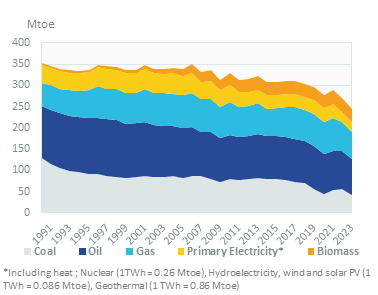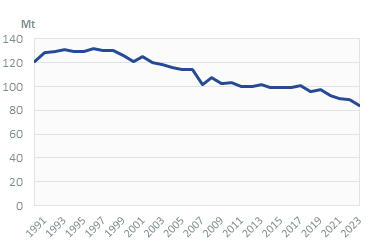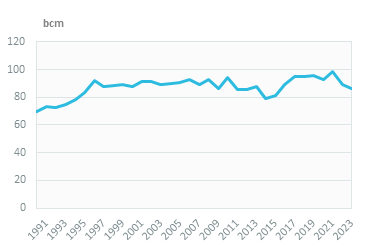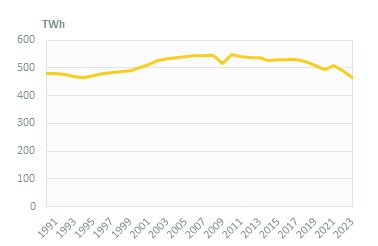-
-
 Energy and Climate Databases
Energy and Climate Databases- The most comprehensive and up-to-date annual energy database.
- Monitoring of technology providers in H2 supply chain.
- Monthly energy data on key energy markets.
- The most reliable and up-to-date power generation database.
- The essentials of LNG trade at your fingertips.
- Global monitoring of new and existing refineries.
- Analyse energy consumption and efficiency trends at world level. Benchmark countries.
- Have your database developed by a recognised expert of both energy and IT.
-
 Energy - Climate Forecasts
Energy - Climate Forecasts- Instant access to energy and emissions forecasts.
- Strategic, annual wholesale price projections backed by Enerdata's energy modelling expertise and our globally recognised POLES model.
- Wedges module showing a breakdown of the levers enabling to reduce emissions between two scenarios.
- Unique, independent projections of consumption by end-use.
- GHG Marginal Abatement Cost Curves.
- Benefit from proven models to draw your own energy scenarios and anticipate tomorrow’s challenges.
-
 Market Intelligence
Market Intelligence- 110 Energy and climate country reports
- A newsletter to receive the latest updates on evolving technologies and policies.
- Global energy news and analyses curated daily.
- Enerdata’s experts bring you the essentials about your market and competitors.
-
-
-
 Market Analysis
Market Analysis- Understanding key consumption trends and drivers across sectors.
- Granular and exclusive insight to address the most pressing business and strategic issues.
- Expertise in strategic and business intelligence, with fine-tuning to the market’s specificities.
-
 Energy - Climate Scenarios
Energy - Climate Scenarios- Providing the outlook of an energy commodity in mid to long term time horizons.
- Sector and driver specific energy demand forecasting.
- Assess the evolution of energy prices on the international and regional markets, as well as end-users prices.
- Enerdata guides you through pathways to reach climate targets.
- Supporting local authorities in their decarbonisation strategies.
-
 Climate Strategy and Policy Evaluation
Climate Strategy and Policy Evaluation- Cutting-edge quantitative tools and relevant indicators to monitor and evaluate evolutions on worldwide energy markets.
- Analysis of the most cost-effective options to reduce emissions.
- Quantified simulation and analysis of pledges for climate change negotiations.
- Breakdown and analysis of carbon markets.
- Enerdata guides you on the most beneficial policy or investment options.
- Turning climate objectives into concrete action plans.
-
 Training
Training- Understand different policy targets and measures on energy efficiency.
- How to measure energy savings?
- Energy Forecasting is a 2 days training to learn to design and interpret energy forecasts.
- Energy statistics training allowing to create energy balance with supply, transformation and consumption and understanding the international energy statistics regulations.
- Initiation to EnerMED level 1is the training to approach on the most powerful energy demand forecasting model.
-
-
Resource Centre
Germany Key Figures
- Population:
- 84.8 million
- GDP growth rate:
- -0.3 %/year
- Energy independence:
- 33.9%
Data of the last year available: 2023
- Total consumption/GDP:*
- 58.6 (2005=100)
- CO2 Emissions:
- 6.74 tCO2/capita
- Rate of T&D power losses:
- 5.24%
* at purchasing power parity
View all macro and energy indicators in the Germany energy report
Germany Related News
View all news, archive your new and create your own daily newsletters only on your topics/countries of interest with Key Energy Intelligence
Germany Related Research
Benefit from up to 2 000 up-to-date data series for 186 countries in Global Energy & CO2 data
A data overview is available in the global energy statistics app
Total Energy Consumption
Per capita consumption decreased further below 3 toe in 2023 (-10%), many due to a lower economy activity and warmer temperature. Per capita electricity consumption also fell to 5,465 kWh.
In 2023, total energy consumption decreased by 9%, reaching 246 Mtoe, its lowest level since the reunification. Previously, it decreased by 1.1%/year over 2016-2019.
Graph: CONSUMPTION TRENDS BY ENERGY SOURCE (Mtoe)

Interactive Chart Germany Total Energy Consumption
Benefit from up to 2 000 up-to-date data series for 186 countries in Global Energy & CO2 data
View the detailed fondamentals of the market at country level (graphs, tables, analysis) in the Germany energy report
Crude Oil Production
Germany relies on imports for more than 96% of its crude oil supply with a declining production, which reached 2.8 Mt in 2023. Crude oil imports declined by 2%/year over 2015-2021, with a 9% rebound in 2022, and decreased further by 13% in 2023 to reach 77 Mt. imports from Russia are near to zero (down from a 35% share in 2021) and are counterbalanced by supply from Norway, UK, Kazakhstan or US.
Interactive Chart Germany Crude Oil Production
Benefit from up to 2 000 up-to-date data series for 186 countries in Global Energy & CO2 data
Additionally, for more detailed information on refineries, you can request a sample of our EMEA Refineries Dataset
Oil Products Consumption
The consumption of oil products decreased further in 2023 to 84 Mt (-6%), after a 2.8% decrease over 2019-2021 (5% in 2020 due to the Covid). From 2012 to 2017, the consumption of oil products remained relatively flat at around 100 Mt.
Graph: OIL CONSUMPTION (Mt)

55% of oil products are consumed in transport, followed by residential & services (16%) and non-energy uses (15%).
Graph: OIL CONSUMPTION BREAKDOWN BY SECTOR (2023, %)
Interactive Chart Germany Refined Oil Products Production
Benefit from up to 2 000 up-to-date data series for 186 countries in Global Energy & CO2 data
Additionally, for more detailed information on refineries, you can request a sample of our EMEA Refineries Dataset
Natural Gas Consumption
Natural gas consumption dropped further by 4% in 2023 (vs 10% in 2022) to 86 bcm, following the shift to other energies. Previously, gas consumption soared by nearly 4%/year over 2014-2019. After a 3% drop in 2020, it increased by 6.5% in 2021.
Graph: NATURAL GAS CONSUMPTION (bcm)

Interactive Chart Germany Natural Gas Domestic Consumption
Benefit from up to 2 000 up-to-date data series for 186 countries in Global Energy & CO2 data
Additionally, for more detailed information on the LNG trade, you can request a sample of our EMEA LNG Trade Dataset
Coal Consumption
Coal and lignite consumption plummeted by 23% in 2023 below their Covid levels of 2020 with 132 Mt, reflecting the end of the temporarily restart of coal and lignite-fired power plants at the end of 2022 and their gradual phase-out. It decreased by 3.5%/year between 2015 and 2018, and by around 20% in 2019 and 2020, following the closure of 9 GW of coal and lignite fired power plants.
Graph: COAL CONSUMPTION (Mt)

Interactive Chart Germany Coal and Lignite Domestic Consumption
Benefit from up to 2 000 up-to-date data series for 186 countries in Global Energy & CO2 data
View the detailed consumption trends at country level (graphs, tables, analysis) in the Germany energy report
Power Consumption
Electricity consumption decreased for the second year in a row by 5% in 2023 to 465 TWh (back to its 1994 level), after a 3.5% rebound in 2021. It decreased by 0.8%/year between 2010 and 2019, with an acceleration since 2017 (-1.6%/year).
Graph: ELECTRICITY CONSUMPTION (TWh).

Electricity consumption is dominated by industry (42% in 2023), followed by the residential sector (28%) and services (24%).
Renewable in % Electricity Production
The Federal Office of Economics and Export Control (BAFA), within BMWi, is the agency that funds the development of renewables.
The NECP targets a share of 30% of renewables in final consumption in 2030 In 2022, this share was 20.8%, of which 50% was for electricity, 42% for heating, and 8% in transport. The 2020 target of 18% was exceeded by 1.1 points.
The Climate action programme (2023) set a target of an 80% share of power consumption by 2030 and 100% by 2035 from renewables.
Interactive Chart Germany Share of Renewables in Electricity Production (incl hydro)
Benefit from up to 2 000 up-to-date data series for 186 countries in Global Energy & CO2 data
Learn more about renewables in the European Battery Market Analysis
CO2 Fuel Combustion/CO2 Emissions
In 2021, Germany updated its climate goals from the Federal Climate Change Act with a revised goal of a 65% cut in GHG emissions by 2030 compared with 1990 and a cut of at 88% cut by 2040, which are also included in the latest NECP. The law prescribes annual emissions budgets, i.e. how much GHG each sector (energy, industry, transport, buildings, agriculture, waste, and others) can emit each year over 2020- 2030. It also brings forward the goal of GHG neutrality by 2045 and introduces a national carbon tax, set at 25€/tCO2 from 2021.